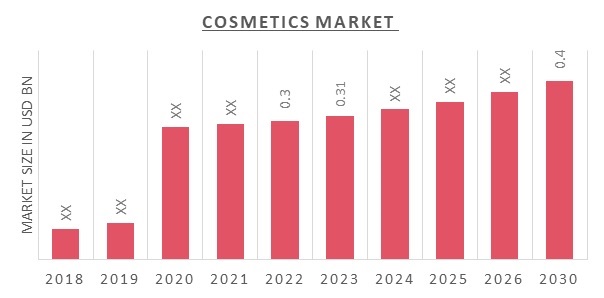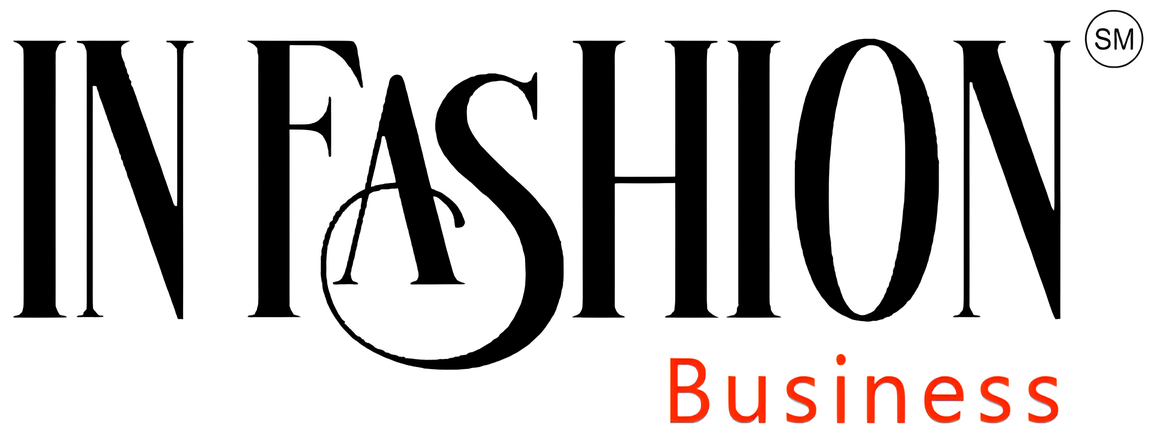COSMETICS GLOBAL
April 14, 2023 | 796 17 minutes read
Cosmetics Market Research report trends and insights information by product type (skin cosmetics, hair cosmetics, nail cosmetics, eye cosmetics and others), by category (organic & natural and conventional), by distribution channel (store-based and non-store-based), and by region (North America, Europe, Asia Pacific, and rest of the World)-competitive market growth, size, share and forecast to 2030.
According to a Comprehensive Research Report by Market Research Future (MRFR), "Cosmetics Market Information by Product Type, Category, Distribution Channel, and Region - Forecast till 2030"; the market will reach USD 0.4 billion by 2030 at a 5.34 percent CAGR.
Market Synopsis
One of the key reasons driving the market growth during the forecast period is the significant expansion in the acceptance of skincare and personal care products, along with the rise in the aging population worldwide. Because they can improve a person's look and benefit personality, cosmetics products have evolved into necessities in life. Several international businesses have been in charge of producing such things. To meet the end-users’ specific needs, they provide a wide range of goods, such as those for the care of the face, hair, and lips, among others. Also, consumers are drawn to the growing number of anti-aging product launches and the creation of simple packaging and small, portable containers. Each person has a unique hair type, skin colour, eye colour, and lip shape. As a result, producers are putting more effort into creating and maintaining a broad range of products that may satisfy each person's unique needs.
Rising styles and considerable product innovation in hair colour and other skincare products' formulations and packaging all contribute to the market's expansion. Manufacturers are altering their product marketing and advertising techniques to increase sales in numerous nations. Manufacturing companies have introduced new goods with all-natural components and appealing packaging as well as other cutting-edge strategies to increase sales of their skincare products. Because cosmetics have become a necessity in people's lives, consumers, particularly women, desire to use cosmetics that are lightweight and convenient to use while commuting or attending social events. Also, using natural ingredients to make cosmetic products that don't hurt the skin is a typical strategy used by manufacturers to attract more clients. However, it is projected that the negative effects of regular usage of cosmetic products brought on by hazardous chemicals will restrain market growth over the projection period.
Global Cosmetics Market Overview
Cosmetics Market Size was valued at USD 0.3 billion in 2022. The cosmetics market industry is projected to grow from USD 0.31 Billion in 2023 to USD 0.4 billion by 2030, exhibiting a compound annual growth rate (CAGR) of 5.34percent during the forecast period (2023 - 2030). Rising Consumer Expenditure on Cosmetics and Personal Care Items, as well as an increase in the number of working women in developing countries are the key market drivers enhancing the market growth.

Source: Secondary Research, Primary Research, MRFR Database and Analyst Review
Cosmetics Market Trends
Rapidly changing worldwide lifestyle is a primary factor driving the cosmetics market growth.
The rapidly changing lifestyle is a primary factor driving the cosmetics business. Furthermore, changing climate conditions in diverse regions such as North America, Europe, Asia-Pacific, and Latin America and the Caribbean (LAMEA) have altered the need for cosmetics and skin care products. Additionally, worldwide per capita income has increased significantly in recent years, particularly in emerging economies. The rise in urbanization and the increase of middle-class consumers in developed and emerging countries has fostered the adoption of convenience-oriented lifestyles, making cosmetics more appealing to customers of all ages, particularly children.
Furthermore, the market is also seeing an increase in demand for natural cosmetics. Manufacturers such as Patanjali, Emami, Loreal, Procter & Gamble Corporation, The Estee Lauder Companies Inc., and others are constantly involved in the production of herbal and natural components cosmetics.Also, rising male awareness of personal grooming and cleanliness has contributed to the market's expansion. Manufacturers' increased use of regressive promotions and ads on social media platforms such as Instagram, Facebook, YouTube, and others have played a vital influence in market CAGR.
Moreover, social commerce is expanding in the context of e-commerce growth. Social commerce enables consumers to interact with companies and purchase products and services. Additionally, online advertising has grown tremendously as it allows for better customer reach in less time. This will drive the cosmetics market revenue.
Cosmetics Market Segment Insights
Cosmetics Product Type Insights
The cosmetics market segmentation, based on product type, includes skin cosmetics, hair cosmetics, nail cosmetics and eye cosmetics. In 2022, the skincare segment contributed to a market share of more than 40 percent because of their variety, skincare cosmetics such as face creams, powders, and sunscreen lotions are becoming increasingly popular. This is the most important aspect in determining market share. Furthermore, the significant popularity of individualized skincare products in developed economies such as the United States, the United Kingdom, and others contributed to segmental expansion. Not only this, the availability of skincare products containing active compounds with healing and nurturing effects aided market expansion.
Figure 1: Cosmetics Market, by Product Type, 2022 & 2030 (USD billion)

Source: Secondary Research, Primary Research, MRFR Database and Analyst Review
Cosmetics category Insights
The cosmetics market segmentation, based on category, the market has been divided into two categories: organic & natural and conventional. The conventional segment held a bigger market share and is expected to grow at a CAGR of 5.21 percent over the forecast period due to its cost effectiveness and ease of availability.
Cosmetics Distribution channel Insights
The cosmetics market data has been bifurcated by distribution channel into store based and non-store based. The store-based categories dominate the market share of more than 75%. Customers' strong preference for store-based retail establishments selling cosmetics products is a crucial factor that has contributed to the segment's dominance. Furthermore, the simple availability of cosmetics and personal care items at brick-and-mortar retail establishments, such as department stores, specialty-multi retailers, and salons and spas, supported revenue growth in the store-based channel sector.
Cosmetics Regional Insights
By Region, the study provides the market insights into North America, Europe, Asia-Pacific and the Rest of the World. In 2022, Asia-Pacific had the greatest market share and is predicted to be the most profitable regional cosmetics market during the research period. The growing popularity of cosmetics in developing nations, together with rising disposable income, is expected to positively influence market growth in Asia-Pacific. Increased consumer expenditure on cosmetics is projected to boost cosmetics sales in Asia-Pacific. Cosmetics makers see tremendous prospects in Asia-Pacific. Manufacturers are launching new products in order to gain a competitive market share in the region.
Further, the major countries studied in the market report are The U.S., Canada, German, France, the UK, Italy, Spain, China, Japan, India, Australia, South Korea, and Brazil.
Figure 2: Cosmetics Market Share by Region (%)

Source: Secondary Research, Primary Research, MRFR Database and Analyst Review
Europe’s cosmetics market accounts for the second-largest market share. The market is primarily driven by the robust sales of cosmetics products from a number of brands, including Coty Inc., L'Oréal S.A., Estée Lauder Companies Inc., and Revlon, Inc., as well as new product introductions from other brands, including Procter & Gamble, Combe Inc., and Henkel AG & Co. KGaA. Another element influencing the industry in the region is the existence of a reputable offline retail chain for cosmetics items in Europe. Further, the Germany cosmetics market held the largest market share, and the UK cosmetics market was the fastest growing market in the European region
The North American Cosmetics Market is expected to grow at the fastest CAGR from 2022 to 2030. One of the main elements contributing to the growth of the North American cosmetics market is prominent manufacturers' expansion of their cosmetics product portfolio. Another important factor influencing the growth of the North American cosmetics market is product portfolio innovation. Moreover, China’s cosmetics market held the largest market share, and the India’s cosmetics market was the fastest growing market in the Asia-Pacific region
Cosmetics Key Market Players & Competitive Insights
Leading market players are investing heavily in research and development to expand their product ranges, which will help the cosmetics industry grow even further. Key market developments include new product releases, contractual agreements, mergers and acquisitions, increased investments, and collaboration with other companies. To expand and remain in a more competitive and rising market climate, cosmetics sector competitors must offer cost-effective merchandise.
Manufacturing locally to minimize operating costs is one of the key business strategies used by manufacturers in the cosmetics industry to benefit customers and develop the market sector. In recent years, the cosmetics sector has supplied medicine with some of the most significant benefits. Major cosmetics market players such as The Estée Lauder Companies Inc. (US), Procter & Gamble Co. (US), L'oréal Group (France), Shiseido Co. Ltd. (Japan), Beiersdorf AG (Germany), and others are aiming to increase market demand by investing in research and development.
Maybelline New York (previously The Maybelline Company and Mabelline and Co, trading as Maybelline (/me.blin/ MAY-bi-leen)) is a New York City-based American multinational cosmetics, skin care, fragrance, and personal care firm. It was established in 1984 in Canada and has been a subsidiary of the French cosmetics firm L'Oréal since 1996. In May 2022.Maybelline New York debuted its newest product, Super Stay Vinyl Ink Liquid Lip Color. The color of the no-budge vinyl lasts up to 16 hours. Among the ten shades of Super Stay Vinyl Ink Liquid Lipcolor are lippy, peachy, coy, red-hot, unparalleled, cheeky, witty, capricious, wicked, and regal.
MAC Cosmetics, stylised as MAC, is a Canadian cosmetics company started in 1984 in Toronto, Canada by Frank Toskan and Frank Angelo. Since becoming a part of Estée Lauder Companies in 1998, the company is based in New York City. Make-Up Art Cosmetics is an abbreviation for Make-Up Art Cosmetics. In May 2022, M.A.C Cosmetics and Netflix cooperated to offer an exclusive Stranger Things beauty collection. The new shades and limited-edition packaging are inspired by the classic Real World Hawkins High and The Upside Down.
Key Companies in the cosmetics market includes
- The Estée Lauder Companies Inc. (US)
- Procter & Gamble Co. (US)
- L'Oréal Group (France)
- Shiseido Co. Ltd. (Japan)
- Beiersdorf AG (Germany)
- Revlon Inc. (US)
- Kao Corporation (Japan)
- Coty Inc. (US)
- Avon Products Inc. (UK)
- Amway Corporation (US)
- Skinfood (South Korea)
- Yves Rocher (France), among others
Market Research Future (MRFR) Market Research Future (MRFR) is a global market research company that takes pride in its services, offering a complete and accurate analysis with regard to diverse markets and consumers worldwide. Market Research Future has the distinguished objective of providing the optimal quality research and granular research to clients. Our market research studies by products, services, technologies, applications, end users, and market players for global, regional, and country level market segments, enable our clients to see more, know more, and do more, which help answer your most important questions.










